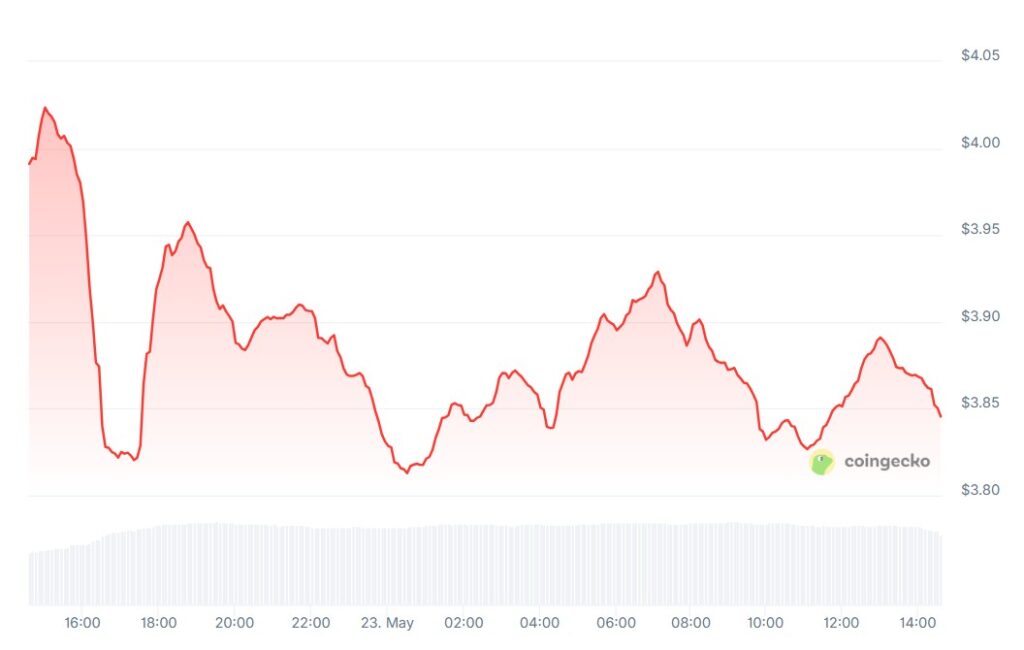The recent events surrounding the Sui-based decentralized exchange, Cetus, have captured considerable attention within the cryptocurrency community. After a significant hack that resulted in a loss of $223 million, the Cetus team has adopted a recovery strategy reminiscent of a successful approach used by Crema Finance, a DeFi project on the Solana blockchain that encountered a similar fate just a year prior. Both platforms share the same development team, leading to intriguing parallels in their response to breaches.
Cetus has publicly offered a bounty to the hacker, asking for the return of all but $6 million—an amount equating to 2,324 Ether (ETH)—in lieu of legal action. This approach invokes a delicate balance between pragmatism and ethical considerations, drawing mixed reactions from their user base. Many community members are voicing discontent, advocating for a more formal compensation plan instead, especially as the value of the CETUS token has drastically dropped following the exploit.
“Even if funds are recovered, most of the damage has already been done,” one user echoed, reflecting the frustration felt by many in the wake of the attack.
Furthermore, Cetus isn’t the only party facing criticism. Sui’s validators are under scrutiny for their role in freezing the stolen assets, a move aimed at hindering the hacker from laundering the funds. Critics argue that this tactic raises concerns about centralization within the network, a significant point of contention given that there are only a limited number of validators involved in the Sui system compared to other blockchains like Ethereum and Solana.
The ongoing discourse not only highlights the persistent security concerns inherent in decentralized finance (DeFi) but also prompts deeper questions regarding the governance and control structures within blockchain networks. As Cetus tries to navigate these tumultuous waters, the future of its relationships with investors and the broader cryptocurrency market remains uncertain. The offer has yet to be accepted by the hacker, who still holds substantial assets linked to the theft, leaving the community in a state of suspense as they await further developments.
The Sui-based DEX Cetus and Its Bounty Offer: Key Points
The recent events surrounding the Cetus DEX and its bounty offer highlight significant issues in the decentralized finance (DeFi) landscape. Here are the key points to consider:
- Cetus’ Bounty Offer:
- Cetus is seeking to recover $223 million lost in a hack by offering a bounty of $6 million for the return of the funds.
- The proposal resembles a past strategy used by the Crema Finance project, which successfully negotiated a recovery of $9 million from a similar hack.
- Community Backlash:
- Users have criticized Cetus for opting for a bounty instead of a formal compensation plan for affected users.
- The value of the CETUS token has plummeted significantly, affecting investors and holders.
- Centralization Concerns:
- Sui validators froze $162 million in stolen funds, leading to criticisms of centralization in an otherwise decentralized network.
- The number of Sui validators is significantly lower than those of Ethereum and Solana, raising questions about the network’s decentralization.
- Legal Implications:
- The hacker involved in the Crema Finance incident was sentenced to prison, which reflects the potential legal consequences of cryptocurrency hacks.
- Cetus is offering an exemption from further legal action, which could set a precedent for future negotiations with hackers.
- Impact on DeFi Security:
- The incident highlights ongoing security challenges in the DeFi space and raises questions about the effectiveness of decentralized governance.
- The differing responses to hacks by various protocols reveal the complexities of managing security and decentralization.
“The debate over decentralization isn’t unique to Sui. This situation reveals how vulnerable even popular DeFi projects can be when it comes to security and governance.”
Cetus vs. Crema Finance: A Comparative Analysis of Recovery Strategies in DeFi
The recent incident involving the Sui-based decentralized exchange (DEX) Cetus has drawn parallels to the unfortunate hack suffered by Crema Finance on Solana three years ago. Both projects, sharing a development team, have employed similar recovery strategies to coax stolen funds back from hackers. While this approach may appear innovative on the surface, it has sparked debate within both communities regarding centralization, user support, and long-term viability.
Competitive Advantages: The Cetus team leverages a tried-and-tested methodology by reaching out to the hacker with a financial incentive to return most of the stolen $223 million. By offering a $6 million reward as well as immunity from legal action, they aim to recover a significant portion of the funds lost. This strategy has successfully borne fruit in the past—you might recall how Crema managed to retrieve a substantial amount after negotiating with their hacker. Additionally, Cetus’s team is backed by a reputation forged in previous high-pressure recoveries, which lends them some credibility in their pursuit of the funds. Engaging the hacker in this manner could also minimize potential long-term damages from legal battles and public relations crises.
Competitive Disadvantages: However, the effectiveness of this approach is under scrutiny. Critics are quick to point out that this reactive measure exhibits a failure to provide a formal compensation plan to affected users, whose trust in the project’s integrity has already waned following a 35% drop in the value of the CETUS token. Many community members are echoing sentiments of discontent, suggesting that simply recovering funds won’t remedy the significant reputational and financial damage inflicted upon token holders. Additionally, the Sui validators’ aggressive action to freeze transactions has raised questions about the underlying ethos of decentralization. While they believe they are acting responsibly to facilitate recovery, this has led to fears of centralization within Sui’s network architecture, a point highlighted by industry observers.
In terms of beneficiary profiles, Cetus’s proposed bounty might create temporary relief for the project itself and its development team, should the negotiated terms encourage the hacker to return funds. However, for the average user and token holder, the fallout is less rosy. The notion of rewarding a hacker—even through attempts to recover stolen funds—can foster an environment of mistrust, making it difficult for users to root for a project they feel has failed to safeguard their investments.
Interestingly, the controversies surrounding Cetus also offer lessons for other DeFi platforms grappling with issues of security and decentralization. Projects like Bybit, which opted for a more hands-off approach following a substantial hack, faced their own criticisms, highlighting the diverse balancing act companies in this space must undertake between safeguarding assets and maintaining user trust. The constant tug-of-war between decentralization and necessary central control in crisis scenarios reveals the challenges that not only Cetus but the entire blockchain ecosystem must face in a rapidly evolving landscape.

















